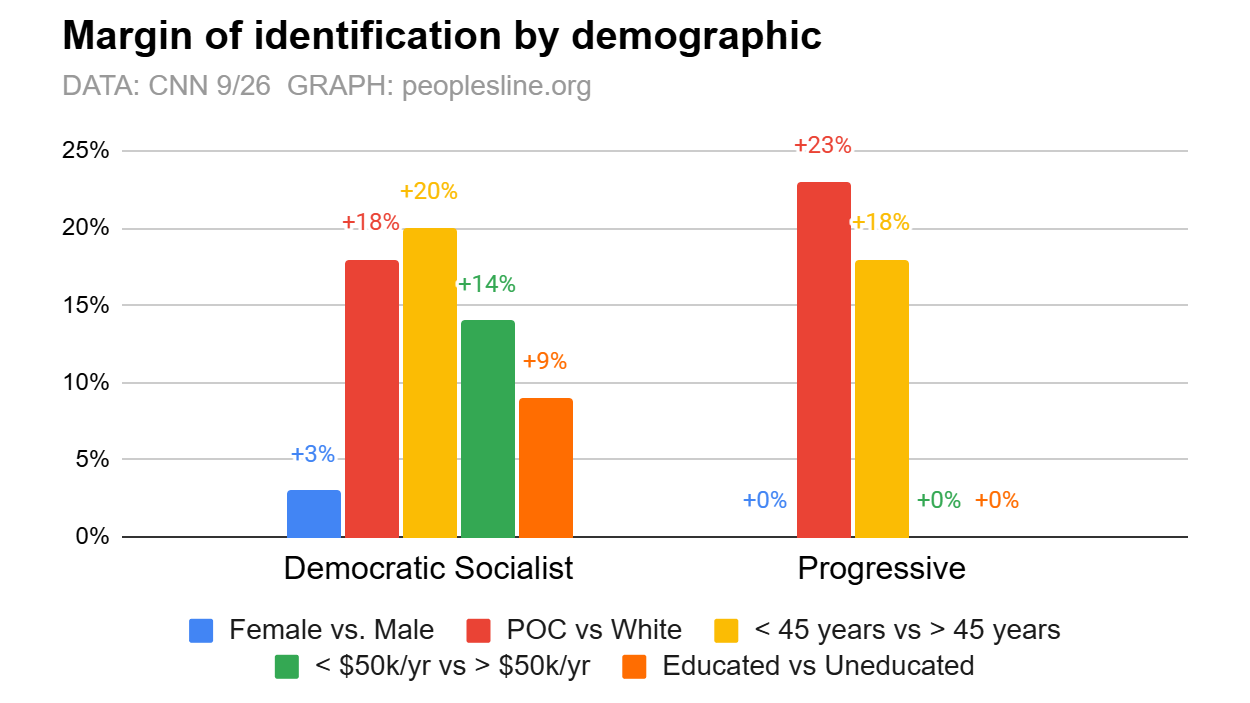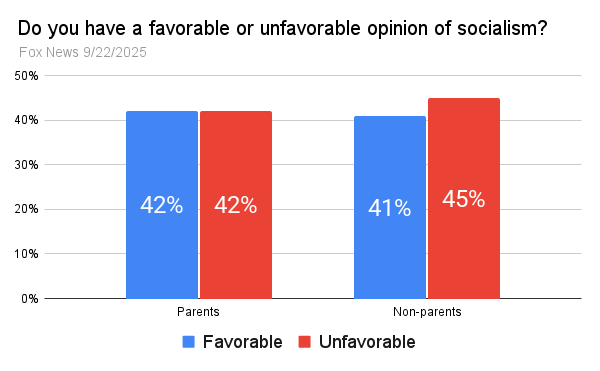The demographics of progressives and socialists
Some rare insights from an unusual CNN poll
Mainstream polling about people who identify as progressive (as opposed to liberal) is rare. Polling about people who identify as democratic socialists is rarer still. And polling that actually provides demographic crosstabs about both groups is so rare that I’ve only ever seen numbers like this one or twice in the past — but CNN, for whatever reason, decided to provide some on Friday.
Here, I thought it would be interesting to compare between ideologies what I call the demographic “margin of identification.” This is just a measure of who, in a given demographic pair, is more likely to identify with a given ideology. The margin of women who identify as democratic socialists, for example, is three points higher than the margin of men who do so; thus, the blue “Female vs. Male” bar below has a score of +3.
Takeaways:
Democratic socialists lean slightly female, whereas progressives have no lean whatsoever.
POC are more likely than whites to identify as democratic socialists and as progressives; the margin of identification is a bit stronger among the latter.
Young people are more likely than old people to identify as both, though here democratic socialists have a stronger lean towards people under 45 than progressives do.
People making less than $50,000 a year are way more likely to identify as democratic socialists than people who make more than that are. There is no such preference among progressives.
Similarly, educated people are signficantly more likely to identify as democratic socialists than uneducated people are; and again, there is no lean here among progressives.
Those last two bullet points are truly remarkable, and not just because the leans are so pronounced. In recent years, it has become an article of faith among “populist” punditry that income and education can be used interchangeably in analyses of political preference. From this perspective, the working class is a group of Americans that is presumably poor and uneducated; the PMCs and bourgeoisie, meanwhile, are the rich and educated.
But these numbers completely break that framework. What they tell us is that the democratic socialists tend to skew poor and educated while progressives tend to skew well-off and uneducated.
There is a tendency in much of the literature on class to take for granted that Americans who are educated but poor are nevertheless upwardly mobile; in its latest report, for example, the Center for Working Class Politics gives the example of an “intern at a tech start-up” whose income is likely to rise in the near future. This picture of the educated poor has often led to a certain anxiety among socialists that even though socialists are disproportionately low earners, they aren’t really working class, and that the “true” working class is unrepresented in socialist organizing. One implication of this is that their socialist politics may just be a transient expression of temporary deprivation; today’s socialist agitating for Medicare for All may very well be tomorrow’s assistant professor who is comfortable with voting blue no matter who because his university provides a strong health care plan.
There may be something to this, but I would like to propose an alternative narrative: today’s democratic socialists are the legacy of the Great Compression. Specifically, they are what happens when your country experiences historically unprecedented prosperity for decades on end; attributes this prosperity to the power of education; and then watches that prosperity slip away since it had more to do with historical circumstance than anything. Today’s democratic socialists may be tech interns, but they are just as likely to be young people who grew up in comfortable middle class homes, went to college, and then entered a brutal 21st century economy with a degree and little else. In the 20th century, their college communist phase would have ended when they got a good full-time job with benefits, a house, a family, and started worrying about taxes. In the 21st century, socialism is their only hope.
In any case, these numbers completely puncture multiple liberal myths about socialists: that we are relatively male, white, well-off, and uneducated. They also cast doubt on a notion that is even popular among some socialists: that socialists and progressives are basically the same group of people, differing only in their tolerance for liberalism. CNN’s poll confirms a lot of intuitions I’ve had about these groups over the years, but in a much more dramatic fashion than even I expected.
BONUS POLL: This is mostly unrelated to everything above, but I can’t help but highlight a Fox News poll that everyone seems to have overlooked:
Conservatives have labored mightily in recent years to paint socialism as uniquely hostile to families, so it’s striking to see that parents are completely ambivalent about it — and that most of the popular hostility towards socialism, in fact, seems to be coming from non-parents. This is a particularly unexpected result given socialism’s relative popularity among young people; clearly we could do with a lot more research into the sociology of socialists.




